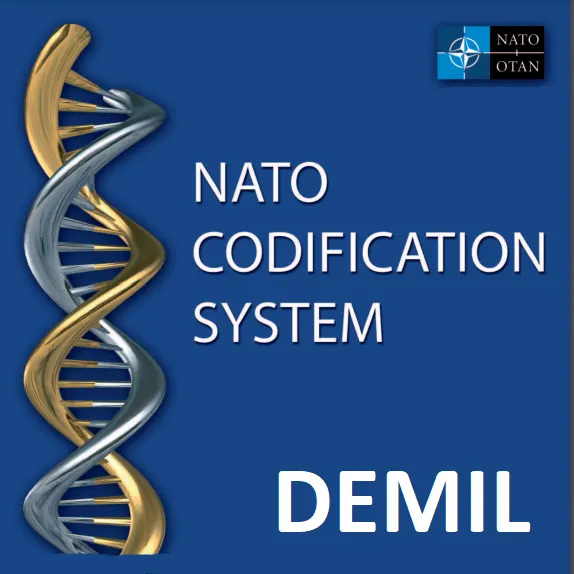DEMIL Codes
Demilitarization (DEMIL) Codes indicate the degree of required physical destruction, identifies items requiring specialized capabilities or procedures, and identifies items which do not require DEMIL but may require Trade Security Controls. It is used throughout the life-cycle to identify control requirements required before release from NATO Military control. A DEMIL Integrity Code appears adjacent to the DEMIL Code in the NATO Stock Number database (military nsn database) to identify the validity of an item’s DEMIL code.
For additional information on DEMIL codes or DEMIL Integrity Codes, see US DOD 4160.28 DEMIL Program, US DOD 4100.39M FLIS Manual or NATO ACodP-1 Manual.

 DEMIL Codes Definition
DEMIL Codes Definition
The DEMIL codes below are listed as the Highest Severity to the Lowest Severity in DEMIL coding. The terminology used here in explanation is USA Centric, but all participating NATO Countries and all Countries who are party to ITAR (International Traffic in Arms Regulations) implement equivalent regulation within their own structure of Government Agencies and Laws.
| DEMIL Code | Severity | Explanation |
|---|---|---|
| G | High | USML or CCL Military Items – DEMIL required – ammunition and explosives (AE). This code applies to both unclassified and classified AE items. |
| P | High | USML Items – DEMIL required. Security classified items. DEMIL of these items consists of destruction to reduce the risk of reconstituting classified information. DEMIL and removal of any sensitive markings or information and certified as such. Communication Security (COMSEC) items must be processed as instructed in the Defense DEMIL Manual. This code cannot be used on ammunition and explosives items. |
| F | High | USML or CCL Military Items – DEMIL required. Item managers, equipment specialists, or product specialists must furnish special DEMIL instructions. The purpose for the instructions is to identify special provisions such as environmental, safety, and health hazards, required occupational expertise, and specific disposition directions. |
| D | High | USML or CCL Military Items – DEMIL required. Destroy item and components to prevent restoration or repair to a usable condition. DEMIL to the level of scrap will ensure the requirements for this code have been met. DEMIL must be witnessed by US Government representatives unless otherwise authorized by the DoD DEMIL Program Manager. |
| C | High | USML or CCL Military Items – DEMIL required. Remove or demilitarize installed key point(s) items as DEMIL code "D". Key points include designed parts, components, alignment points, attachment fittings or areas which, when demilitarized, cannot feasibly be restored and which are necessary features in restoring the next higher assembly to design capability. |
| E | Medium | DoD DEMIL Program Office reserves this code for its exclusive-use only. DEMIL instructions must be furnished by the DoD DEMIL Program Office |
| B | Medium | USML Items – Mutilation (MUT) to the point of scrap required worldwide. |
| Q | Low | Commerce Control List Item (CCLI) – Mutilation (MUT) is required to the point of scrap outside of the United States. Inside the United States, mutilation is required when the DEMIL Integrity Code (IC) is “3” and mutilation is not required when the DEMIL Integrity Code is "6". |
| A | Low | Items that have not been modified or redesigned and which are identical in design, structure, composition and utility to an equivalent item in the commercial market, will be coded DEMIL code A. Items subject to the US Export Administration Regulations (EAR) in parts 730-774 of Title 15, Code of Federal Regulations (CFR) (CCLI or EAR99) and determined by the US Department of Defense to present a low risk when released out of US Department of Defense control. No Demilitarization (DEMIL), Mutilation (MUT) or End Use Certificate (EUC) is required. May require an export license from the US Department of Commerce. |
 DEMIL Codes FAQ
DEMIL Codes FAQ
- Why the NATO Phonetic Alphabet?
- The NATO Phonetic Alphabet was developed in the 1950s to be intelligible and pronounceable to all NATO allies in the heat of battle. The clarity of communication and the use of easily learnable words taught by NATO Phonetic Alphabet Chart led to its global adoption in the following years.
- Why is the NATO Phonetic Alphabet Global?
- While other phonetic or more correctly, spelling alphabets, existed since the invention of radio communication, during the Second World War (1939 through 1944) more than 70 million people were enlisted in the military under the Allied and Axis Countries. Every troop's basic training included proficiency in the NATO Phonetic Alphabet. Moreover, the support and administration staff supporting the militaries and governments of this time also became proficient. It is therefore safe to say that more than 10% of the world population were fluently utilizing the NATO Spelling alphabet in their daily lives come 1944 regardless of their primary language and it developed into habit. There have only been minor modifications and clarifications since that time.
- What other Names does the NATO Alphabet have?
- The NATO Phonetic Alphabet is not technically a Phonetic Alphabet. It is a spelling alphabet which is also known as a Radio Alphabet, Military Alphabet, ICAO (International Civil Aviation Organization) Code, Radiotelephony Alphabet or International Telecommunication Union (ICU) Alphabet. Each "version" of these spelling alphabets has slight deviation, but as of 2022, the alphabets are almost all identical.
- Do Countries have their own Phonetic Alphabets?
- Yes, there are country, regional and language specific phonetic alphabets. The English Language is still the international standard for the Financial, Aviation and Military communities so the NATO Phonetic Alhpabet is by far the widest used. For example, the US Financial Alphabet, the Spanish Phonetic Alphabet and the French Phonetic Alphabet.
